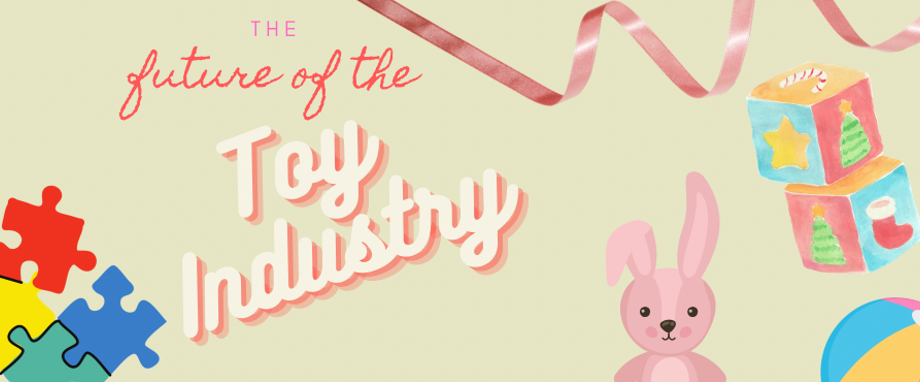Author: Vaishali Bansal, Graphics: Irina Sakharova
The BRB Bottomline
With the rise of technology in the modern-day digital era, the physical toy industry has taken quite a hit. How has technology changed the toy industry for good? And how can these businesses smoothly transition into the digital world?
To this day, I can still clearly remember the stocked shelves of colorful toys and the comforting presence of Geoffrey the Giraffe at my local Toys R Us. Growing up, I would spend hours trading Silly Bandz, playing endless rounds of Bop It, and completing long–yet rewarding–journeys in the Game of Life. However, in today’s world, Toys R Us is a thing of the past and many of my favorite childhood pastimes have started to feel archaic and obsolete. My younger cousins have barely spared a glance at my collection of toys, rather opting to play on their new iPad or PS4s. This rise in technology and social media has shifted the pre-teen demographic like never before; kids are growing up faster compared to previous generations, and are increasingly demanding digital goods in comparison to traditional toys. For the major toy manufacturers out there, this change could spell significant trouble.
Analyzing Sales Data
This exponential–and sudden–growth in technology had indirectly started a downwards trend in the toy industry. All of the major toy companies have started to face significant decreases in sales and demand over the past decade. For instance, Mattel Inc, the manufacturer of Barbie dolls, reported a 14% and 15% decline in net and gross sales in 2015 and 2017, respectively. There were “major declines in sales of its core toys such as Barbie, American Girl, and the Construction and Arts & Crafts.” Similarly, LEGO, which reported its first revenue decline in 2017, had to let go of more than 8% of its global workforce as a result. Moreover, with the sudden wave of lockdowns brought in by the coronavirus, many toy manufacturers are facing crumbling supply chains and consequent losses. A study found that the top twenty-five toy companies “could lose up to $3 billion from COVID-19.”
All the data is pointing to a significant decline in sales revenue and demand, signaling that a similar end to that of Toys R Us is near for many toy manufacturers. Or is it? The toy industry is still raking in more than 20.7 billion dollars in sales a year, which begs the question: is the toy industry actually in danger?
E-commerce and Toy Markets
This does not mean that the toy industry is dead for good. A 2018 survey found that 61% of American parents still prefer physical toys and games, compared to a meager 14% that prefer digital toys. Moreover, although major suppliers like Mattel, Hasbro, and Target showed no increase in toy sales during the holiday season, Amazon did. This data signals that the bankruptcy of stores like Toys R Us may be the result of a shift to online sellers, rather than a decrease in demand. The rise of technology and the internet has led to a permanent shift from traditional toy stores to online sellers; only 28% of parents opt to buy toys in-person in the United States, compared to 61% who do so online. Amazon’s success has shown that the problem lies not within the lack of demand, but rather the lack of adaptation. For instance, instead of improving their business strategy, Toys R Us held onto their ineffective and outdated business model, even in the face of the e-commerce boom. Furthermore, COVID-19 has actually proved to be a saving grace for many toy brands. As kids are stuck at home, parents are rushing to buy toys to uplift their children’s moods in what has been described as “COVID-19 guilt”.
Strategies for a Smooth Transition
One way that toy manufacturers can make a comeback is by tapping into the educational toy market. 58% of parents prefer to buy educational toys, and they are consistently ranked as some of the best-sellers in the toy industry. A research study found that the educational toy market has the potential to grow by 28.40 billion dollars by 2025. Some traditional toy stores have also tried–and succeeded– at transitioning their businesses online. One premier example is LEGO, which has successfully built its customer base and figured out how to maintain demand for their products in a digital world. From creating LEGO movies to introducing augmented reality apps that go hand-in-hand with their products, LEGO has cemented itself as a top toy manufacturer. Other toy companies should look to brands like LEGO and Hasbro, when attempting to appeal to a new generation of technology-driven consumers.
These leading companies are just a few examples that prove that a successful transition to our modern day, digital world is still feasible. Businesses just need to figure out how to best satisfy the demand. With even Toys R Us announcing a comeback in the following year, the physical toy market has been and will continue to be a driving force in the American economy for years to come.
Take-Home Points
- Technological growth has led to long-lasting changes in the toy industry, as children start to demand and consume more digital toys.
- Many leading toy manufacturers such as Toys R Us and Mattel have faced decreasing revenue and are struggling to maintain sales.
- Most toy businesses are having trouble, not because of the lack of demand, but rather their inefficient business models that no longer work in the digital age.
- Toys–regardless of whether they’re physical or digital–will always be in demand.
- E-commerce has mostly replaced physical toy stores; large online retailers such as Amazon are the reason many traditional companies are facing losses.
- The fact of the matter is that the toy industry is far from dead. Companies like LEGO have shown that a successful transition to the digital age is never too late.


TOY INDUSTRIES
ARE
LOOKING
FOR
CHANGE
BUT
WHAT?